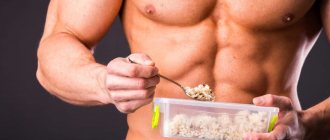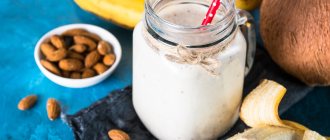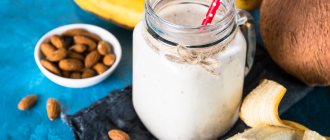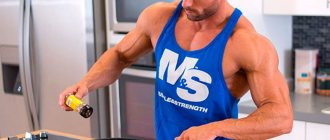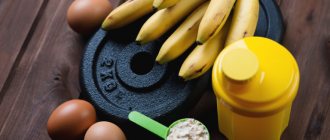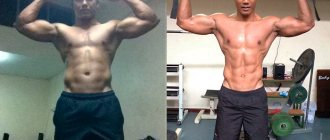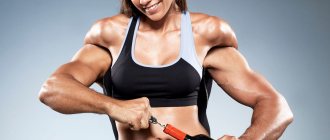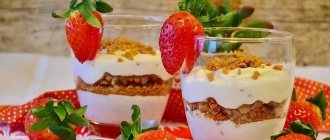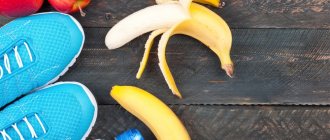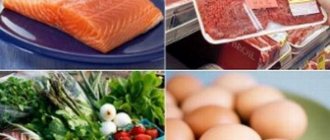Bodybuilders and advanced sports enthusiasts often use the expression “protein-carbohydrate window.” This concept refers to the period of time after active exercise, when the rate of breakdown of food increases many times over. Moreover, the calories received are not stored in reserve, but are spent on restoring energy. It’s difficult to say exactly how long the carbohydrate window lasts, but approximately 20-90 minutes.
During an exhausting workout, the body enters a stressful state. At this time, all forces for survival are mobilized: blood flow changes, pressure rises, stress hormones are released - cortisol and adrenaline. A high concentration of signaling molecules (hormones) changes the entire biochemical picture. In order not to cause damage to health and to correct physical condition, endorphin is released into the blood, opening a second wind.
What happens after training?
After the body has spent energy and suffered microdamage to muscle fibers, it needs immediate replenishment of energy and nutrients for recovery. During this period, which usually lasts no more than 40 minutes, the body best absorbs carbohydrates and proteins necessary for both weight gain and weight loss.
The uniqueness of the post-workout period is that carbohydrates are completely absorbed, both simple and complex, so subcutaneous fat is not deposited. This means that “closing” the protein-carbohydrate window is necessary both when gaining weight and when losing weight (including cutting).
Anabolism and catabolism
Anabolism is a set of chemical processes aimed at creating new cells and tissues. To put it exaggeratedly, these are the processes of muscle tissue growth. The process absolutely opposite to anabolism is catabolism. Catabolism is the process of metabolic breakdown into simpler substances to release energy. For an athlete, what plays a role in the first place is how exactly this energy is generated. We are interested in the catabolism (breakdown) of proteins, or more precisely, how to prevent this, because in this case, our muscles will be used as an energy source (I wrote in detail about the formation of energy in the article “When is the best time to do cardio?”).
What happens if you fast after a workout?
- Firstly, microdamaged muscles will not be filled with nutrients, which means they will not grow. Therefore, the window is often called anabolic.
- Secondly, stress hormones (cortisol and adrenaline) during fasting after exercise destroy muscles.
- Third, insulin, which is produced by the body when eating carbohydrates, does not increase and does not fight stress hormones.
- Fourthly, with prolonged fasting, metabolism slows down, even for those losing weight who do not gain muscle - this process is destructive. It is known that with a slow metabolism, the body is worse at parting with its own fats.
Does leucine require insulin to stimulate synthesis?
A review by Stark et al (1) states that leucine cannot stimulate protein synthesis as effectively as it does in the presence of insulin. However, the studies cited as confirmation (2, 3) were performed on cell cultures (invitro), the results of which are not always applicable to the situation in a living organism (invivo). In contrast to the physiological state, where even during an overnight fast there are low but measurable levels of circulating insulin (~5 mU/L) (4), cell cultures that were stimulated or not stimulated with insulin were compared (2, 3). But the more important fact is that increasing insulin levels to more than 30 times fasting levels does not further increase protein synthesis, even at very high serum amino acid levels (4). So technically, insulin is actually needed to increase protein synthesis when amino acids are elevated. But even very low levels of insulin can work together with leucine to induce protein synthesis. Additionally, it should be noted that leucine consumption can induce insulin secretion (5, 6), and most studies of protein intake have reported a significant increase in circulating insulin—at least 2 to 3 times higher than fasting values (7, 8).
How to close the carbohydrate window after training?
Carbohydrates
Since carbohydrates are divided into two types - fast and slow, it is important to choose the type of nutrient for your own goals.
- For those gaining weight , carbohydrate intake should account for the lion's share of the serving. A fast (simple) carbohydrate can cause a rapid spike in insulin, which quickly reduces cortisol production.
- After strength training for weight loss, it is necessary to close the carbohydrate window with complex, long-digesting nutrients.
Simple carbohydrates are baked goods and confectionery products, fruits, juices. Complex - cereals and grains, durum pasta, non-starchy vegetables.
Squirrels
Another essential nutrient that breaks down into amino acids that form new muscles. Proteins are needed both for weight gain and for weight loss. If during mass gain the majority of the portion is made up of carbohydrates, then when losing weight it’s the other way around – proteins predominate. Their advantage is that excess protein does not turn into fat, and they also do not contain sugars, hence the glycemic index. When choosing protein products, choose lean meat - poultry, beef, fish, as well as low-fat dairy products and eggs.
Sports nutrition
To make life easier for athletes, sports nutrition manufacturers have developed cocktails that replace meals and replenish all the nutrients needed after a workout. These products include: protein shakes, gainers, protein and carbohydrate bars. Products can be selected based on needs; a high concentration of carbohydrates is found in gainers and high-carbohydrate bars, and proteins are found in protein, especially isolate.
Recipes for protein-carbohydrate dishes
If your workout occurs in the morning, you can consume carbohydrates to lose weight. Protein smoothies are more suitable for covering carbohydrate protein in the evening. It is also possible to mix proteins with carbohydrates, but in the evening it is better to avoid sweet foods and high-calorie ingredients. When choosing a specific recipe, you need to focus on calorie content. It should not be more than 50% of those burned during training.
Banana milkshake
This is one of the easiest smoothie recipes that you can use to close the carb window after a workout for weight loss. You can drink it both in the morning and in the evening, using it as a light dinner. For taste, you can flavor the cocktail with cinnamon or ginger. These spices have a fat-burning effect and help cleanse the body of waste and toxins. Banana can also be used for garnish by adding a few slices to the top of the smoothie.
Ingredients:
- skim milk – 300 ml;
- ripe banana – 1 pc.
Cooking method:
- Peel the banana, chop and place in a blender.
- Pour milk into it, preferably chilled.
- Beat the drink until smooth and foamy.
Carbohydrate smoothie with kiwi, mango and honey
This cocktail has a very unusual taste thanks to the combination of kiwi and mango. The latter fruit provides the body with many vitamins, relieves heartburn and even relieves stress. No less useful is kiwi, which contains beta-carotene, fiber, pectin and magnesium. This fruit promotes weight loss due to the antioxidants in its composition, but they are present in the skin, so it can also be consumed.
Ingredients:
- mango – 150 g;
- skim milk – 300 g;
- kiwi – 2 pcs.;
- honey – 1 tbsp.
Cooking method:
- Peel the fruit, you can leave the kiwi with the skin.
- Cut them into small cubes, place in a blender bowl, and blend.
- Pour in cold milk and beat the ingredients again.
- Then add honey. Whip the smoothie one last time until smooth.
Cottage cheese cocktail with oatmeal
Oatmeal is a representative of slow carbohydrates, which ensures satiety and vigor for 3-4 hours. Cottage cheese is good for metabolism, and it is also slowly absorbed. In addition, the body expends a lot of energy to process this dairy product. As a result, for several hours after eating cottage cheese, calories are spent on it.
Ingredients:
- skim milk – 0.5 tbsp.;
- cottage cheese with fat content 1% – 200 g;
- banana – 1 pc.;
- oat flakes – 100 g.
Cooking method:
- Cut the banana into pieces and place in a blender bowl. Grind until smooth.
- Add the cottage cheese mashed with a fork. Beat everything again.
- Pour in the cereal and pour in the milk. Beat one last time until smooth.
Protein window after cardio workout
If after strength training fat burning continues for another 2-4 hours, then after stopping the cardio load it stops immediately as soon as the pulse returns to normal. Therefore, it is not worth replenishing lost glycogen reserves after such loads; the lost calories will immediately come from food.
In this case, there is a need to close, rather, the protein window . The supply of amino acids from proteins will prevent muscle breakdown and will not slow down the weight loss process, provided that simple carbohydrates are abandoned. After cardio, you can take lean protein foods, whey protein (sports nutrition) and amino acids.
Can insulin suppress protein breakdown?
It is unlikely that a physiological increase in insulin concentration can stimulate an increase in protein synthesis in the body, but does this apply to protein breakdown? A study by Borsheim et al (9) showed that consuming 100 g of carbohydrates after resistance exercise was able to improve muscle protein balance by reducing protein degradation rather than by increasing protein synthesis. However, a small increase in insulin levels from protein ingestion after resistance exercise is also sufficient to suppress protein degradation (10).
What is the connection between carbohydrates and endurance?
Dr. Monique Ryan, author of Nutrition for Endurance Sports, explains that when you eat a bowl of pasta, most of the carbohydrates are stored as glycogen in the muscles and liver. Glycogen is the most accessible form of energy when covering a distance, but not its only source.
What is glycogen, how does it affect our workouts and is it possible to increase its reserves in the body?
At distances of a half marathon or longer, you burn both glycogen and fat. But fat is a less efficient source of energy, so the body has to work harder to convert it into fuel.
When you run out of glycogen during a race, you hit what's called a "wall": your movement slows as your body tries to convert fat into energy. This is why the correct layout is important when covering a distance, because glycogen reserves are only enough for 90 minutes of intense running.
If you're running a marathon, you need to have a clear idea of an average pace that will burn glycogen and fat in the right proportions and that won't take you to the wall in the second half of the race.
How to properly load with carbohydrates?
Harvard University professor and amateur marathon runner with a personal best of 2:55 Benjamin Rapoport suggests the following scheme, similar to that used by professional athletes:
- 6 weeks before your marathon: Try eating a little more carbs two days before your long run. You will be able to check which products are suitable for you and which are not. Experiment as part of your preparation for the start. Be sure to check sports nutrition (gels, isotonic drinks) while jogging.
- The week before the marathon: Make a meal plan for the last week and race based on your experience. Decide how many gels and what drinks you will need to cover the distance.
- 2-3 days before the marathon: from this point on, 85-95% of your diet should be carbohydrates only. It's best to load up immediately after training. At this moment, muscles are most actively absorbing glycogen.
- The day before the start: do not overeat. Dinner should be rich in carbohydrates, but there is no need to have a feast. Eat dinner early so you have time to digest everything before going to bed. You should wake up in the morning feeling slightly hungry.
- Morning before the race: 3 hours before the start of the race, eat 150 grams of carbohydrates, such as a bagel and yogurt. If the start is very early in the morning, then get up at 3 am, throw food into yourself and go to sleep for the remaining time.
